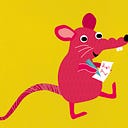How to Be Happy Lesson #14: Don’t Be
Although the Ren & Stimpy chorus “Happy! Happy! Joy! Joy!” might seem like the ideal state of mind for one to aspire to every day, there are some that argue otherwise. One such person is Dinsa Sachan, a science and culture journalist who tells us “Don’t worry about feeling sad: on the benefits of a blue period.” Sachan relates the story of writer Melissa Broder, a person who tells the world about her “mundane sadness” via a Twitter account called So Sad Today (@sosadtoday).
Broder tweets things like “waking up today was a disappointment” or “what you call a nervous breakdown I call oops, accidentally saw things are they are.” Apparently, people want to hear these things as Broder has 800,000 followers and counting and has published a book of personal essays about her mental-health battles with the same title as her Twitter account.
I am in agreement with Sachan when she writes “it’s startling that Broder’s unabashed expression of sadness — and all the shitty emotions — has struck such a nerve in a world where people’s social media profiles are immaculately curated to show their happiest selves.” Sachan then mentions “self-help” books from the 16th century that “try to encourage sadness in readers by giving them lists of reasons to be disappointed.” Next, she asks the $64,000 question: “Can it be that the path leading to true happiness goes via sadness?”
Some would answer yes — in particular a 2016 study that “suggests that experiencing not-so-happy feelings actually promotes psychological wellbeing.” Western culture isn’t much help in this regard. We are four to ten times more likely to experience clinical depression and anxiety than those living in an Eastern culture. “In China and Japan,” Sachan writes, “both negative and positive emotions are considered an essential part of life. Sadness is not a hindrance to experiencing positive emotions and — unlike in Western society — there isn’t a constant pressure to be joyful.” Then she quotes a psychologist, who explains, “The point is that when we try and avoid sadness, see it as a problem, and strive for endless happiness, we are in fact not very happy and, therefore, cannot enjoy the benefits of true happiness.”
That must be part of the appeal of Broder’s Twitter account. If you need to be sad to be happy, how much better to let someone else be sad for you? Broder does this for us in real life. Cartoonists do it for us in imaginary worlds. According to the “Top 10 Saddest Cartoon Characters of All-Time,” Charlie Brown is the leader in this regard (“Sigh!”): “The strip [Peanuts] demonstrates the struggle, pain, and downright misery of childhood, all through one hapless individual: Charlie Brown.”
My favorite on this list, however, is #10: Lamington, the Saddest Dog in the World (and Friends). Lamington “is a Boston terrier puppy who lacks the ability to feel joy of any kind, and just wants to be left alone with a migraine.” The strip conveys a lesson similar to the psychologist above:
His friends, being the modern sociopaths that they are, want to cheer him up by any means necessary. Which is kind of a metaphor for society in general. In today’s world, it is notOK to be sad. For example, you can’t turn up to your dead end job in a shitty mood and curse everyone out, even though that is the correct response to the situation. No, everyone must be happy all the time. It’s a facade and Lamington is the poster boy for emotional honesty.
So, Lesson #14 on how to be happy appears to be this: we can’t know what happiness is without experiencing sadness. I’m not sure I agree with this, but I’m willing to give it a try. I’m going to start marking my calendar as follows: the odd days will be labeled with this tweet from Broder: “Life is like a heavy annoying blanket” or maybe “oh, great, I’m awake.” The even days will be labeled, naturally, “Happy! Happy! Joy! Joy!” This pattitude [attitude pattern] should establish an emosinave [emotional sine wave] that achieves selfarmony [harmony of self]. I might call this technique something like the Hapsad Method. I will let you know if it works — after, of course, I receive the trademark and patent for it.
[Published originally on RatBlurt™, March 13, 2019.]
